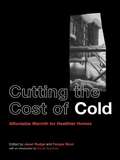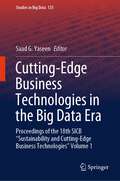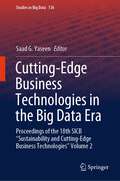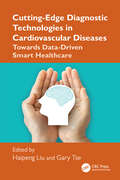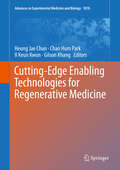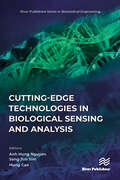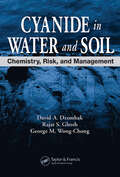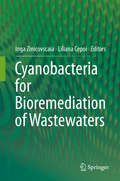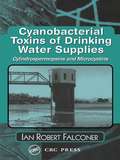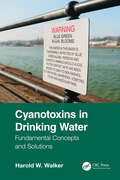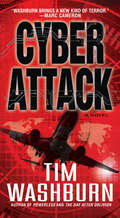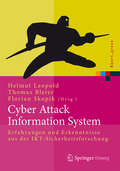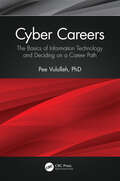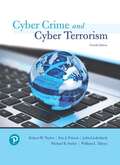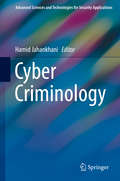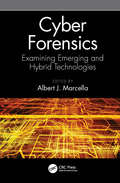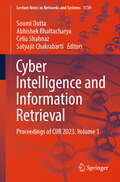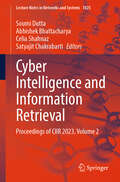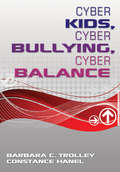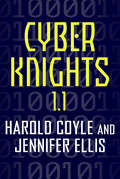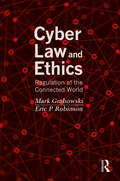- Table View
- List View
Cutting the Cost of Cold: Affordable Warmth for Healthier Homes
by Fergus Nicol Janet RudgeIn this book academics and practitioners from a wide range of disciplines provide a survey of research into buildings, epidemiology and medical issues, followed by an assessment of the tools available to the practitioner. The book goes on to provide clear guidance on putting theory into practice.This will be a powerful reference source and a compelling read for a wide range of built environment and health professionals from surveyors to environmental health officers.
Cutting-Edge Business Technologies in the Big Data Era: Proceedings of the 18th SICB “Sustainability and Cutting-Edge Business Technologies” Volume 1 (Studies in Big Data #135)
by Saad G. YaseenThis book highlights applied artificial intelligence techniques, tools, and systems to drive strategic advantages, improve operational efficiency, and create added value. The focus is very much on practical applications and how to maximize the value of these technologies. They are being applied across businesses to enhance innovation, improve performance, increase profit, support critical thinking, and ultimately create customer-added value. Whether you are a researcher, manager, or decision-maker, this book provides valuable insights to help you harness the power of AI and big data analytics in your organization. This book attempts to provide answers to the most important questions: Quo Vadis applied artificial intelligence? Quo Vadis cutting-edge business technologies?
Cutting-Edge Business Technologies in the Big Data Era: Proceedings of the 18th SICB “Sustainability and Cutting-Edge Business Technologies” Volume 2 (Studies in Big Data #136)
by Saad G. YaseenThis book highlights applied artificial intelligence techniques, tools, and systems to drive strategic advantages, improve operational efficiency, and create added value. The focus is very much on practical applications and how to maximize the value of these technologies. They are being applied across businesses to enhance innovation, improve performance, increase profit, support critical thinking, and ultimately create customer-added value. Whether you are a researcher, manager, or decision-maker, this book provides valuable insights to help you harness the power of AI and big data analytics in your organization. This book attempts to provide answers to the most important questions: Quo Vadis applied artificial intelligence? Quo Vadis cutting-edge business technologies?
Cutting-Edge Diagnostic Technologies in Cardiovascular Diseases: Towards Data-Driven Smart Healthcare
by Gary Tse Haipeng LiuThis book provides a comprehensive overview of cutting-edge technologies in the diagnosis of multiple cardiovascular disease. Readers will understand technical advancements and research gaps, which will help them to optimize the design of algorithms and devices.Cutting-Edge Diagnostic Technologies in Cardiovascular Diseases: Towards Data-Driven Smart Healthcare provides details on the adoption and implementation of advanced diagnostic techniques in different clinical settings, including population screening, clinical diagnosis, risk prediction, data-driven diagnosis, and remote healthcare monitoring. It also covers various cardiovascular diseases, from the macrovascular to microvascular levels, where early and accurate diagnosis is a high clinical need, for example, stroke, intracranial atherosclerosis, coronary artery disease, and microvascular dysfunction. The book is a practical guide with case studies, and the authors cover a wide range of cutting-edge diagnostic techniques, including artificial intelligence, radiological imaging, wearable sensors, genetic biomarkers, and multi-omics data integration. It summarizes the potentials, challenges, and ethical concerns in the implementation of these techniques under current clinical settings. It also discusses the future directions and perspectives for next-generation diagnostics based on AI-enhanced multimodal data fusion.This book targets a mixed audience of data scientists, engineers, clinicians, researchers, academics, and students interested in cutting-edge technologies, methodologies, and practices in the diagnostics of cardiovascular diseases to resolve the challenging gaps in healthcare and clinical applications.
Cutting-Edge Enabling Technologies for Regenerative Medicine (Advances in Experimental Medicine and Biology #1078)
by Heung Jae Chun Gilson Khang Chan Hum Park Il Keun KwonThis book explores in depth the latest enabling technologies for regenerative medicine. The opening section examines advances in 3D bioprinting and the fabrication of electrospun and electrosprayed scaffolds. The potential applications of intelligent nanocomposites are then considered, covering, for example, graphene-based nanocomposites, intrinsically conductive polymer nanocomposites, and smart diagnostic contact lens systems. The third section is devoted to various drug delivery systems and strategies for regenerative medicine. Finally, a wide range of future enabling technologies are discussed. Examples include temperature-responsive cell culture surfaces, nanopatterned scaffolds for neural tissue engineering, and process system engineering methodologies for application in tissue development. This is one of two books to be based on contributions from leading experts that were delivered at the 2018 Asia University Symposium on Biomedical Engineering in Seoul, Korea – the companion book examines in depth novel biomaterials for regenerative medicine.
Cutting-edge Technologies in Biological Sensing and Analysis (River Publishers Series in Biomedical Engineering)
by Hung Cao Anh Hung Nguyen Sang Jun SimAdvanced technologies have been transforming the ways we carry out biological studies as well as deliver healthcare. While micro- and nano-fabrication have provided miniaturized sensors and systems with better sensitivity and selectivity,; innovations in flexible electronics, biomaterials and telecommunications have helped in enabling novel biomedical devices, reducing cost, bringing convenience and establishing mobile-health (m-Health), and personalized- and tele-medicine. Further, the recent rise of the internet of things (IoTs) and machine learning-based approaches has paved the avenue for those biomedical systems to become popular and widely accepted by our society. In this context, we edit this book aiming to cover a broad field of novel technologies used in biological assessment and analysis for humans, animal models and in vitro platforms, in both health monitoring and biological studies. Technical topics discussed in the book include: Biosensing systems and biomedical techniques Imaging techniques and systems Biosignal analysis Animal models used in biological research
Cyanide in Water and Soil: Chemistry, Risk, and Management
by David A. Dzombak Rajat S. Ghosh George M. Wong-ChongPresenting the state-of-the-art in managing cyanide across a wide range of industrial and environmental contexts, this book brings together current knowledge about cyanide release to and behavior in the environment and explores how to control or remediate these releases. No other broad-based examination of this topic exists. The authors address the full range of issues pertaining to cyanide fate, transport, treatment, and toxicity in water and soil as well as approaches currently used in risk assessment and management. They have developed a careful balance of depth and scope of coverage, providing current references that help readers learn more about topics of particular interest.
Cyanobacteria Biotechnology: Sustainability of Water-Energy-Environment Nexus
by Ramaraj Boopathy Muhammad Aamer Mehmood Syed Ghulam Musharraf Sana Malik“Dive into a Sustainable Future with Cyanobacteria Biotechnology” Explore the boundless potential of cyanobacteria in “Emerging Trends in Cyanobacteria Biotechnology”. This comprehensive volume, curated by leading experts, showcases cutting-edge research and practical applications across environmental sustainability, human health, and beyond. It will be the book of your choice to discover innovative methodologies and breakthroughs in carbon capture, bioprocessing, and metabolic engineering, illuminating cyanobacteria's pivotal role in shaping a sustainable future. Whether a researcher, student, entrepreneur, or industry professional, this book is your gateway to interdisciplinary collaboration and ground-breaking innovation. Join us on a journey to harness the power of cyanobacteria—let's build a healthier, more sustainable world together. Your next big idea starts here!
Cyanobacteria for Bioremediation of Wastewaters
by Inga Zinicovscaia Liliana CepoiThis book reflects the use of cyanobacteria for the bioremediation of wastewater through different mechanisms and pathways of transformation and transfer of hazardous substances from one medium to another. The application of microorganisms for bioremediation is determined by their ubiquity, small size, high rate of reproduction and large surface-to-volume cell ratio. Mechanisms of interaction of cyanobacteria with inorganic pollutants include biosorption, bioaccumulation with an opportunity to obtain metal nanoparticles both on the cell surface and inside the cells as well as chelation and inclusion of metals in the composition of certain organic structures. Data presented in the book provides specialists in the field with useful information for bioremediation technologies as well as for obtaining valuable preparations using cyanobacteria.
Cyanobacterial Toxins of Drinking Water Supplies
by Ian Robert FalconerThe contamination of both drinking and recreational water supplies by cyanobacteria is increasingly a cause for concern worldwide. While contamination causes livestock deaths with relative frequency, acute poisoning is rare in humans. However, there is growing apprehension over the possible role of cylindrospermopsins and microcystins in gastrointe
Cyanotoxins in Drinking Water: Fundamental Concepts and Solutions
by Harold WalkerThis textbook provides students with a more holistic, systems-based perspective of harmful algal blooms, or HABs and HAB toxins, while explaining details on occurrence, health effects, and treatment processes for the removal of HAB cells and toxins from drinking water. It includes significant content on basic concepts, and system design, and includes thought-provoking problems and questions to inspire further studying, making it suitable for senior undergraduate and graduate-level students. It also serves as a useful resource for professionals and academics in technical activities related to HABs and HAB toxins in drinking water.Features Provides answers to the complex problem of HABs and HAB toxins in drinking water, as well as an up-to-date review of the literature. Covers solutions to HABs and HAB toxins in drinking water in the context of a changing climate. Explains key concepts and terms, detailed analysis, and design examples, in an easy-to-understand language for students and professionals interested in HABs. Includes worked example problems and numerous questions to better illustrate the concepts and solutions to HABs and HAB toxins in drinking water. A “Solutions Manual” is provided. Offers comprehensive coverage of HABs and HAB toxins in drinking water, from occurrence to in situ treatment to treatment in treatment facilities. Features case studies from different countries that have proposed regulations for HABs and related toxins in drinking water. This is an excellent resource for use in courses that take an interdisciplinary approach to water treatment, such as environmental, marine, and atmospheric sciences. It can be used also for continuing education in water-treatment-related fields, and a reference for technical activities related to HABs and HAB toxins in drinking water.
Cyber Attack
by Tim WashburnA novel of high-tech terrorism from &“the equal of any top-selling thriller novelist, such as James Rollins, Douglas Preston, Lincoln Child and others&” (The Oklahoman).THIS IS NOT A TESTIt begins with a computer malfunction. A 737 passenger jet drops from the sky from 34,000 feet. Then another. And another. At the same time, the unthinkable happens in our nuclear power plants. Water pumps fail. Nuclear cores melt. Untold millions could die . . .THIS IS THE FUTURE OF TERRORWith each passing hour, orchestrated cyber attacks unleash a massive wave of death and utter destruction. Chemical plants explode. Floodgates burst open. Power grids self-destruct. From Wall Street to Washington, the fear is going viral—and the panic could lead to the total annihilation of America.THIS IS WORLD WAR 3.0Missiles and guns are useless. Generals and diplomats are powerless. America&’s last hope lies with two specially trained FBI agents: Hank Goodnight and computer programmer Paige Randall, who must penetrate the darkest recesses of the web and infiltrate the twisted network of a faceless enemy. And dare to fight fire with fire—apocalypse be damned . . .Praise for the writing of Tim Washburn&“Washburn brings a new kind of terror.&” —Marc Cameron,New York Times–bestselling author&“Like a nuclear reactor, this story heats up fast!&” —Anderson Harp, author of the Will Parker Thrillers &“Apocalypse has come . . . Unsettling . . . Washburn shows formidable storytelling skills.&” —Mystery Scene
Cyber Attack Information System: Erfahrungen und Erkenntnisse aus der IKT-Sicherheitsforschung (Xpert.press)
by Florian Skopik Helmut Leopold Thomas BleierIn den letzten Jahren hat sich das Internet schnell zu einem massiven wirtschaftlichen Betätigungsfeld entwickelt, leider auch für illegale Unternehmungen. Das Ausnutzen von Schwachstellen in IKT-Systemen ist inzwischen ein profitables Geschäftsmodell. Das staatlich geförderte Forschungsprojekt CAIS beschäftigte sich deshalb mit der Implementierung eines Cyber Attack Information Systems auf nationaler Ebene mit dem Ziel, die Widerstandsfähigkeit der heutigen vernetzten Systeme zu stärken und ihre Verfügbarkeit und Vertrauenswürdigkeit zu erhöhen. Hauptziele dieses Projektes waren die Identifizierung der künftigen Cyber-Risiken und -Bedrohungen, die Untersuchung neuartiger Techniken zur Anomalieerkennung, die Entwicklung modularer Infrastrukturmodelle und agentenbasierter Simulationen zur Risiko- und Bedrohungsanalyse, und schließlich die Analyse und mögliche Umsetzung eines nationalen Cyber Attack Information Systems.
Cyber Careers: The Basics of Information Technology and Deciding on a Career Path
by Pee VulullehThe approach taken in this book emphasizes the basics of information technology and helps students decide whether to pursue an information technology career. Most students fail to pursue an IT career because of their limited knowledge (sometimes no knowledge) about the area. Similarly, most students pursuing a career in IT do not research the field before their pursuit. This book is purposely designed for students in this category. The book may be offered as a required text for an elective or core course to all bachelor's degree students regardless of specialization. Compared to other textbooks, this text guides students pursuing or wanting to pursue an IT degree/career. Most students often begin their study of IT without knowing the outside and inside of the area. Most of these students can change their minds to pursue a different career path after spending several semesters of studies, a waste of their time. If students are taught from the onset about what an IT career entails and what it takes to become successful, it will significantly help students and not waste their time. This book addresses the issue.
Cyber Crime and Cyber Terrorism
by Michael Saylor Robert Taylor John Liederbach Eric Fritsch William TafoyaThis book is a comprehensive introduction to the acts and theories of cyber crime, cyber terrorism, and information warfare. Assuming no prior knowledge of technology, the authors cover the types of crimes and terrorist acts committed using computer technology, theories addressing hackers and other digital criminals, and investigative, research, and legal strategies targeting these acts. Like no other on the market, the text bridges the gap between criminal justice knowledge and the technical issues that arise during investigations of cyber crime. The 4th edition adds material on new technologies and trends, plus updated review questions and activities.
Cyber Criminology (Advanced Sciences and Technologies for Security Applications)
by Hamid JahankhaniThis book provides a comprehensive overview of the current and emerging challenges of cyber criminology, victimization and profiling. It is a compilation of the outcomes of the collaboration between researchers and practitioners in the cyber criminology field, IT law and security field.As Governments, corporations, security firms, and individuals look to tomorrow’s cyber security challenges, this book provides a reference point for experts and forward-thinking analysts at a time when the debate over how we plan for the cyber-security of the future has become a major concern. Many criminological perspectives define crime in terms of social, cultural and material characteristics, and view crimes as taking place at a specific geographic location. This definition has allowed crime to be characterised, and crime prevention, mapping and measurement methods to be tailored to specific target audiences. However, this characterisation cannot be carried over to cybercrime, because the environment in which such crime is committed cannot be pinpointed to a geographical location, or distinctive social or cultural groups. Due to the rapid changes in technology, cyber criminals’ behaviour has become dynamic, making it necessary to reclassify the typology being currently used. Essentially, cyber criminals’ behaviour is evolving over time as they learn from their actions and others’ experiences, and enhance their skills. The offender signature, which is a repetitive ritualistic behaviour that offenders often display at the crime scene, provides law enforcement agencies an appropriate profiling tool and offers investigators the opportunity to understand the motivations that perpetrate such crimes. This has helped researchers classify the type of perpetrator being sought. This book offers readers insights into the psychology of cyber criminals, and understanding and analysing their motives and the methodologies they adopt. With an understanding of these motives, researchers, governments and practitioners can take effective measures to tackle cybercrime and reduce victimization.
Cyber Crisis: Protecting Your Business from Real Threats in the Virtual World
by Eric ColeBased on news reports, you might think there's a major cybersecurity threat every four to five months. In reality, there's a cybersecurity attack happening every minute of every day. Today, we live our lives—and conduct our business—online. Our data is in the cloud and in our pockets on our smartphones, shuttled over public Wi-Fi and company networks. To keep it safe, we rely on passwords and encryption and private servers, IT departments and best practices. But as you read this, there is a 70 percent chance that your data is compromised . . . you just don't know it yet. Cybersecurity attacks have increased exponentially, but because they're stealthy and often invisible, many underplay, ignore, or simply don't realize the danger. By the time they discover a breach, most individuals and businesses have been compromised for over three years. Instead of waiting until a problem surfaces, avoiding a data disaster means acting now to prevent one. In Cyber Crisis, Eric Cole gives readers a clear-eyed picture of the information war raging in cyberspace. Drawing on 30 years of experience—as a professional hacker for the CIA, as the Obama administration's cybersecurity commissioner, and as a consultant to clients around the globe from Bill Gates to Lockheed Martin and McAfee—Cole offers practical, actionable advice that even those with little technical background can implement, including steps to take on a daily, weekly, and monthly basis to protect their businesses and themselves. No matter who you are or where you work, cybersecurity should be a top priority. The information infrastructure we rely on in every sector of our lives—in healthcare and finance, for governments and private citizens—is both critical and vulnerable, and sooner or later, you or your company will be a target. This book is your guide to understanding the threat and putting together a proactive plan to minimize exposure and damage, and ensure the security of your business, your family, and your future
Cyber Defence in the Age of AI, Smart Societies and Augmented Humanity (Advanced Sciences and Technologies for Security Applications)
by Hamid Jahankhani Stefan Kendzierskyj Nishan Chelvachandran Jaime IbarraThis publication highlights the fast-moving technological advancement and infiltration of Artificial Intelligence into society. Concepts of evolution of society through interconnectivity are explored, together with how the fusion of human and technological interaction leading to Augmented Humanity is fast becoming more than just an endemic phase, but a cultural phase shift to digital societies. It aims to balance both the positive progressive outlooks such developments bring with potential issues that may stem from innovation of this kind, such as the invasive procedures of bio hacking or ethical connotations concerning the usage of digital twins. This publication will also give the reader a good level of understanding on fundamental cyber defence principles, interactions with Critical National Infrastructure (CNI) and the Command, Control, Communications and Intelligence (C3I) decision-making framework. A detailed view of the cyber-attack landscape will be garnered; touching on the tactics, techniques and procedures used, red and blue teaming initiatives, cyber resilience and the protection of larger scale systems. The integration of AI, smart societies, the human-centric approach and Augmented Humanity is discernible in the exponential growth, collection and use of [big] data; concepts woven throughout the diversity of topics covered in this publication; which also discusses the privacy and transparency of data ownership, and the potential dangers of exploitation through social media. As humans are become ever more interconnected, with the prolificacy of smart wearable devices and wearable body area networks, the availability of and abundance of user data and metadata derived from individuals has grown exponentially. The notion of data ownership, privacy and situational awareness are now at the forefront in this new age.
Cyber Forensics: Examining Emerging and Hybrid Technologies
by Albert J. MarcellaThreat actors, be they cyber criminals, terrorists, hacktivists or disgruntled employees, are employing sophisticated attack techniques and anti-forensics tools to cover their attacks and breach attempts. As emerging and hybrid technologies continue to influence daily business decisions, the proactive use of cyber forensics to better assess the risks that the exploitation of these technologies pose to enterprise-wide operations is rapidly becoming a strategic business objective. This book moves beyond the typical, technical approach to discussing cyber forensics processes and procedures. Instead, the authors examine how cyber forensics can be applied to identifying, collecting, and examining evidential data from emerging and hybrid technologies, while taking steps to proactively manage the influence and impact, as well as the policy and governance aspects of these technologies and their effect on business operations. A world-class team of cyber forensics researchers, investigators, practitioners and law enforcement professionals have come together to provide the reader with insights and recommendations into the proactive application of cyber forensic methodologies and procedures to both protect data and to identify digital evidence related to the misuse of these data. This book is an essential guide for both the technical and non-technical executive, manager, attorney, auditor, and general practitioner who is seeking an authoritative source on how cyber forensics may be applied to both evidential data collection and to proactively managing today’s and tomorrow’s emerging and hybrid technologies. The book will also serve as a primary or supplemental text in both under- and post-graduate academic programs addressing information, operational and emerging technologies, cyber forensics, networks, cloud computing and cybersecurity.
Cyber Intelligence and Information Retrieval: Proceedings of CIIR 2021 (Lecture Notes in Networks and Systems #291)
by João Manuel R. S. Tavares Paramartha Dutta Soumi Dutta Debabrata SamantaThis book gathers a collection of high-quality peer-reviewed research papers presented at International Conference on Cyber Intelligence and Information Retrieval (CIIR 2021), held at Institute of Engineering & Management, Kolkata, India during 20–21 May 2021. The book covers research papers in the field of privacy and security in the cloud, data loss prevention and recovery, high-performance networks, network security and cryptography, image and signal processing, artificial immune systems, information and network security, data science techniques and applications, data warehousing and data mining, data mining in dynamic environment, higher-order neural computing, rough set and fuzzy set theory, and nature-inspired computing techniques.
Cyber Intelligence and Information Retrieval: Proceedings of CIIR 2023, Volume 1 (Lecture Notes in Networks and Systems #1139)
by Satyajit Chakrabarti Abhishek Bhattacharya Soumi Dutta Celia ShahnazThis book gathers a collection of high-quality peer-reviewed research papers presented at International Conference on Cyber Intelligence and Information Retrieval (CIIR 2023), held at Institute of Engineering & Management, Kolkata, India during 14 – 15 December 2023. The book covers research papers in the field of privacy and security in the cloud, data loss prevention and recovery, high performance networks, network security and cryptography, image and signal processing, artificial immune systems, information and network security, data science techniques and applications, data warehousing and data mining, data mining in dynamic environment, higher order neural computing, rough set and fuzzy set theory, and nature inspired computing techniques.
Cyber Intelligence and Information Retrieval: Proceedings of CIIR 2023, Volume 2 (Lecture Notes in Networks and Systems #1025)
by Satyajit Chakrabarti Abhishek Bhattacharya Soumi Dutta Celia ShahnazThis book features selected research papers presented at the 2nd International Conference on Cyber Intelligence and Information Retrieval (CIIR 2023) held at the Institute of Engineering & Management, Kolkata, India, in association with CSI Kolkata section on 14-15 December 2023. Cyber intelligence and information retrieval are closely related fields that deal with the collection, analysis, and utilization of data and information from various digital sources. These fields are crucial in today's digital age, where vast amounts of data are generated and stored electronically. By combining the strengths of cyber intelligence and information retrieval, organizations can enhance their ability to detect, respond to, and mitigate cyber threats, while also improving their overall cybersecurity posture and decision-making processes. This book comprises high-quality research work by academicians and industrial experts in the field of artificial intelligence, data analytics, computing, and communication, including full-length papers, research-in-progress papers, and case studies related to all the areas of data analytics, machine learning, Internet of Things (IoT), information security, etc.
Cyber Kids, Cyber Bullying, Cyber Balance
by Constance Hanel Barbara C. TrolleyEmphasizing prevention, assessment, and evaluation, this proactive guide shows how to advance learning, reduce cyber bullying, and improve school climate by helping students use technology responsibly.
Cyber Knights 1.1
by Harold Coyle Jennifer EllisCyber Knights 1.1 is the second part in a stunning two-part collection of stories based on true-life cyber vulnerabilities, by Harold Coyle and Jennifer EllisHere be Dragons. In the Age of Discovery, unexplored areas of a map were often marked with this warning. Today, such a warning could easily be applied to the internet. Hackers and cyber assassins present a constant threat to individuals, companies, and institutions. Protecting these targets requires a new kind of warrior, a cyber knight armed with the skills, weapons, and savvy needed to slay today's dragons. One such digital warrior is Andy Webb, a former British Army officer. Together with Karen Spencer, a shy, twenty-something American who is a wizard when it comes to software, and Tommy Tyler, a rough and ready ex-soldier and hardware expert, Webb forms Century Consultants. The cyber security firm must work to defend its clients from the hackers, criminals and hired cyber assassins who seek out victims on the world wide web.
Cyber Law and Ethics: Regulation of the Connected World
by Eric P. Robinson Mark GrabowskiA primer on legal issues relating to cyberspace, this textbook introduces business, policy and ethical considerations raised by our use of information technology. With a focus on the most significant issues impacting internet users and businesses in the United States of America, the book provides coverage of key topics such as social media, online privacy, artificial intelligence and cybercrime as well as emerging themes such as doxing, ransomware, revenge porn, data-mining, e-sports and fake news. The authors, experienced in journalism, technology and legal practice, provide readers with expert insights into the nuts and bolts of cyber law. Cyber Law and Ethics: Regulation of the Connected World provides a practical presentation of legal principles, and is essential reading for non-specialist students dealing with the intersection of the internet and the law.
